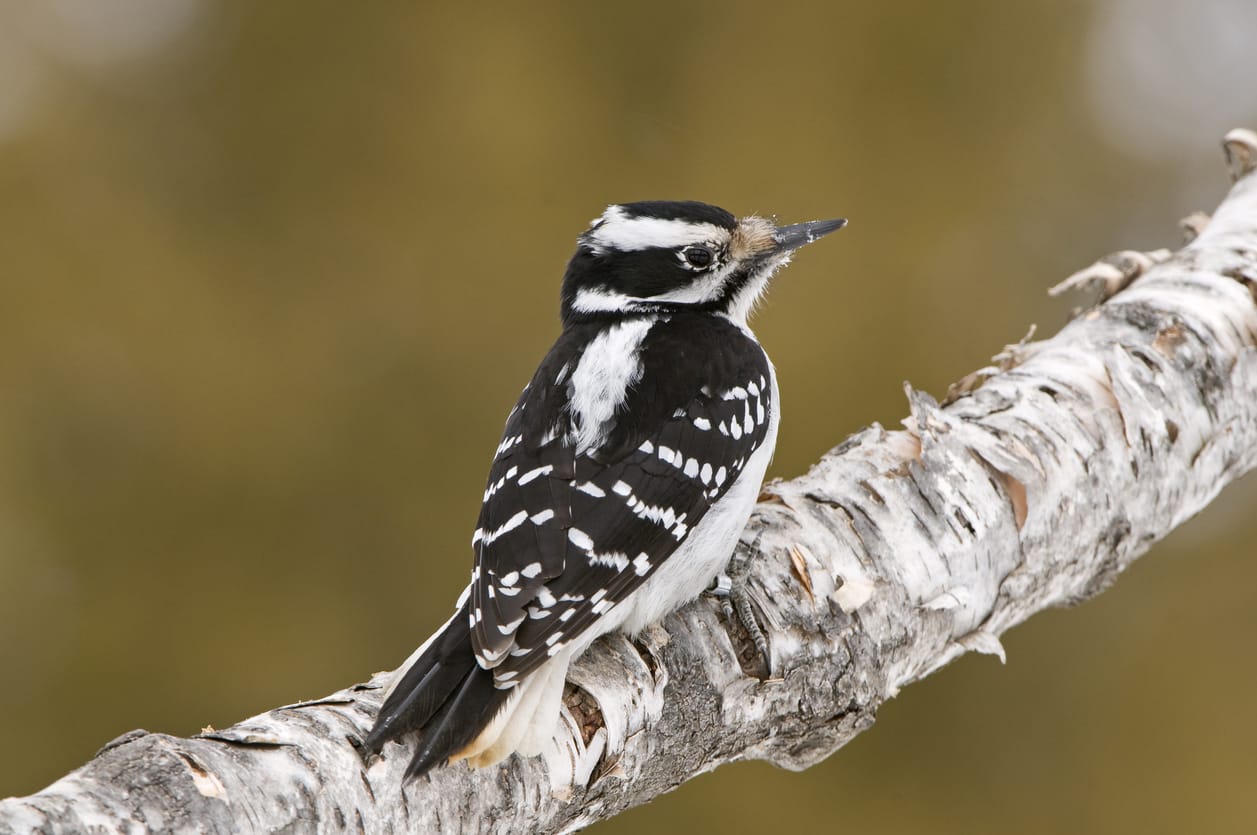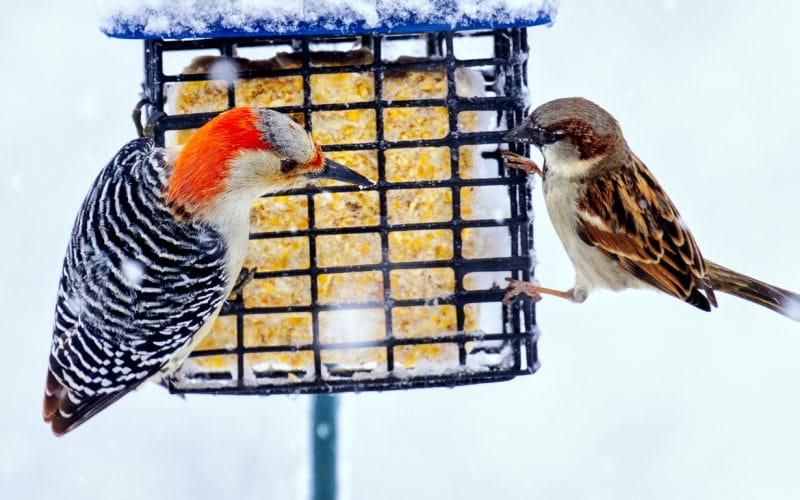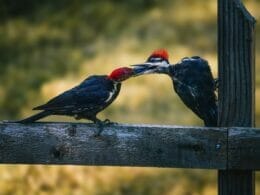Bird watching can be an incredibly calming activity. It’s especially fun when you get to see new types of birds flying around.
If you’re in the Missouri area, you’ll probably get to see a few woodpeckers. So, let’s take a look at 10 species of woodpeckers in Missouri and where you can find them.
1. Downy Woodpecker
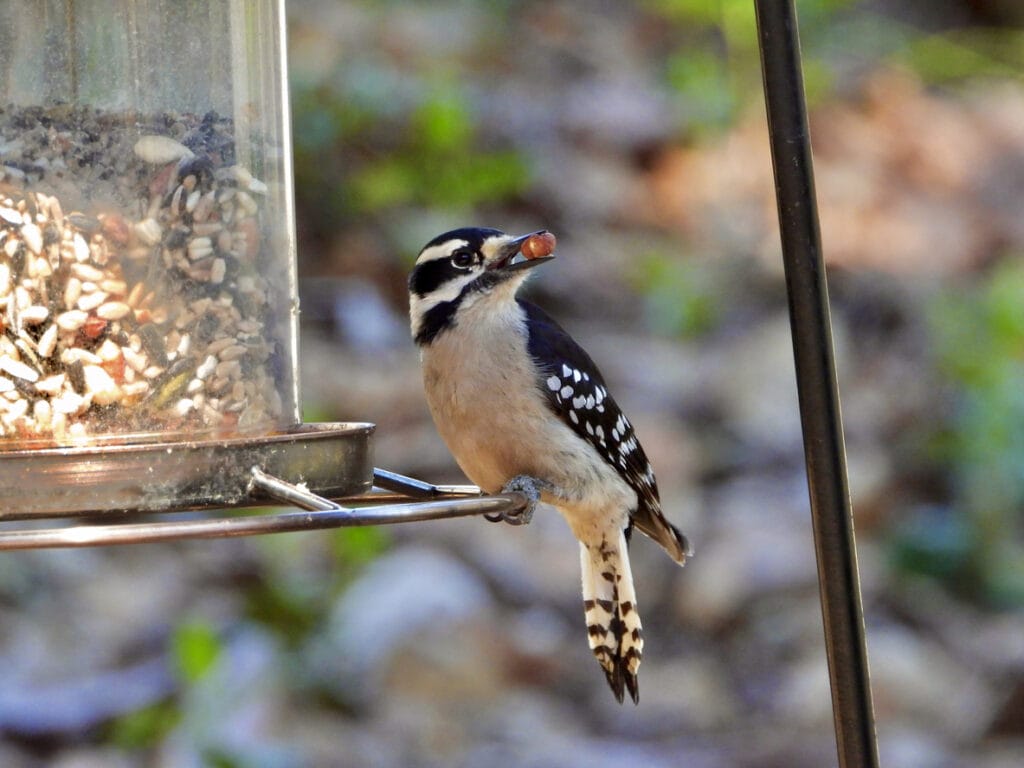
- Scientific name: Dryobates pubescens
- Length: 5.5 to 6.7 inches
- Weight: 0.7 to 1.0 ounces
- Wingspan: 9.8 to 11.8 inches
- Average life span: 1 to 2 years
- Status: Least concern
You can often see Downy Woodpeckers flying around Missouri. Even though you’re more likely to see them in the winter, these birds fly around all year long.
Author Note: The Downy Woodpecker may be common, but that doesn’t mean it’s easy to spot. Downy Woodpeckers are the smallest species of peckers in Missouri. This makes them incredibly skilled at staying out of sight.
These peckers have a black and white feather coat. The coat is mostly black, with many tiny white spots all over. That coat adds to the Downy’s ability to camouflage itself.
The trick to finding a Downy Woodpecker is to let them come to you. This pecker loves bird feeders. So, instead of going out into the woods to find one, you may want to check your backyard.
You’ll know if a Downy Woodpecker is there because of their call. They make a slow, loud drumming noise.
2. Hairy Woodpecker
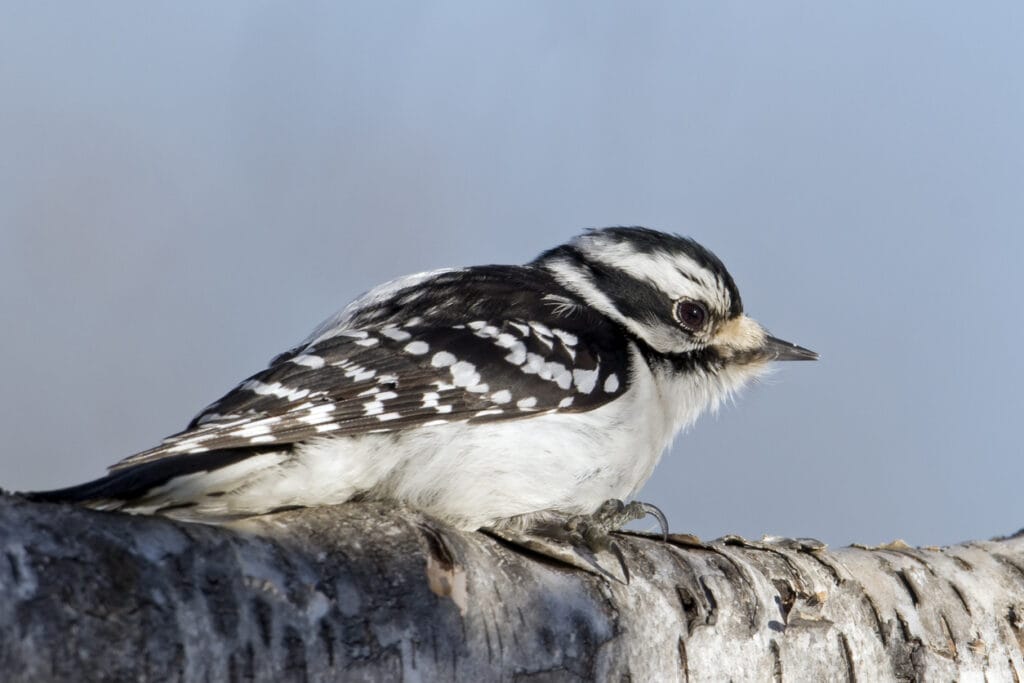
- Scientific name: Leuconotopicus villosus
- Length: 7.1 to 10.2 inches
- Weight: 1.4 to 3.4 ounces
- Wingspan: 13 to 16.1 inches
- Average life span: 12 to 15 years
- Status: Least concern
The Hairy Woodpecker is much easier to find. This bird is common around Missouri, but it prefers to come out during the winter.
Hairy Woodpeckers have a similar appearance to Downy Woodpeckers. They both have black feathers with white spots. The males also have a small red streak on their heads.
Even though this bird looks similar to the Downy Woodpecker, it’s much larger. This makes it much easier to spot between trees.
Still, you’ll probably hear this bird before you see it. The Hairy Woodpecker has an incredibly loud call that sounds like high-pitched screeching.
These birds like to nest in dead tree trunks and branches. They also like to keep close to the ground. Their primary food source comes from insects, so they spend most of their days foraging.
3. Lewis’s Woodpecker
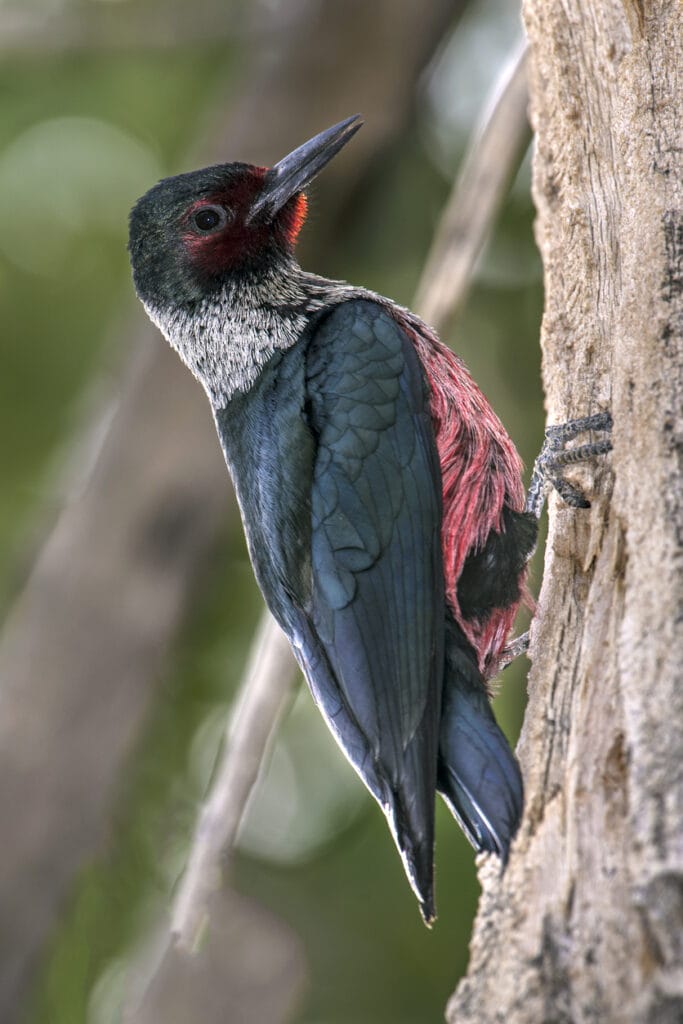
- Scientific name: Melanerpes lewis
- Length: 10.2 to 11.0 inches
- Weight: 3.1 to 4.9 ounces
- Wingspan: 19.3 to 20.5 inches
- Average life span: 5 to 10 years
- Status: Least concern
Although it doesn’t visit Missouri often, you can sometimes see Lewis’s Woodpecker. These birds can visit during their mating time. So, the best time to see these peckers is from April to July.
Most woodpecker species are black and white, with a touch of red. However, Lewis’s Woodpecker doesn’t follow this palette. This pecker has a gray neck and a dark red face. It also has a soft pink belly. The stark difference in colors makes these birds easy to identify.
Unlike most other peckers, Lewis’s Woodpecker doesn’t spend its day hammering trees. Instead, it prefers to spend its time hunting down prey.
Lewis’s Woodpeckers mostly eat flying insects. They can catch them right out of the sky. You can also see them eating fruits and other berries.
When it comes to nesting, Lewis’s Woodpeckers are a little lazy. They overtake another bird’s nest, instead of building their own.
4. Pileated Woodpecker

- Scientific name: Dryocopus pileatus
- Length: 15.8 to 19.3 inches
- Weight: 8.8 to 12.3 ounces
- Wingspan: 25 to 30 inches
- Average life span: 10 to 12 years
- Status: Least concern
You can spot a Pileated Woodpecker all year round in Missouri. They like to spend most of their time around woodlands and forests.
Top Tip: The Pileated Woodpecker is visually similar to the Ivory-billed Woodpecker. They’re both mostly black with white stripes. However, the Pileated pecker is a little smaller.
Still, these woodpeckers are relatively large. For this reason, they have one of the loudest calls. They make a rattling noise that sounds like distant laughter.
The Pileated Woodpecker also has a larger red flash than the Ivory-billed Woodpecker. The red feathers start from the bill and go all the way down its head. Males also have a tiny patch of red feathers on their cheeks.
These birds can eat insects, berries, and some trees. They especially like dogwood trees.
5. Yellow-Bellied Sapsucker

- Scientific name: Sphyrapicus varius
- Length: 7.1 to 8.7 inches
- Weight: 1.5 to 1.9 ounces
- Wingspan: 13.4 to 15.8 inches
- Average life span: 5 to 8 years
- Status: Least concern
Yellow-bellied Sapsuckers like to follow the warmth. So, throughout the year, you can find them in southern Missouri. They’re also migratory birds, which means they move around a lot. For this reason, you may not have to wait till summer to see a Yellow-bellied Sapsucker.
This bird’s coat is mostly white, with many black dots covering the surface. It also has a patch of red feathers on its forehead. Males will have an additional patch of red on the front of their necks.
The majority of a Yellow-bellied Sapsucker’s diet consists of sap. They can eat the sap from many types of trees for this, but they prefer birch and maple trees.
So, if you’re looking for a Yellow-bellied Sapsucker, try looking for these trees. You’ll know if a pecker was there because they leave horizontal rows of sap holes.
6. Northern Flicker

- Scientific name: Colaptes auratus
- Length: 11.0 to 12.2 inches
- Weight: 3.9 to 5.6 ounces
- Wingspan: 16.5 to 20.1 inches
- Average life span: 6 to 9 years
- Status: Least concern
Another common Missouri bird is the Northern Flicker. This woodpecker flies around Missouri all year. Still, they fly out in bigger numbers during the winter.
Top Tip: A Northern Flicker’s main body is a grayish-white. It has a barred pattern on its wings and a dotted pattern on its bellies.
Some Northern Flickers will have an extra patch of red or yellow on their tails. This patch can help you tell where the pecker comes from and its migration patterns.
What makes this species of woodpeckers special is that they spend most of their time on the ground. They spend that time looking for their favorite snack, ants. On average, the Northern Flicker consumes more ants than any other bird species.
7. Red-Bellied Woodpecker
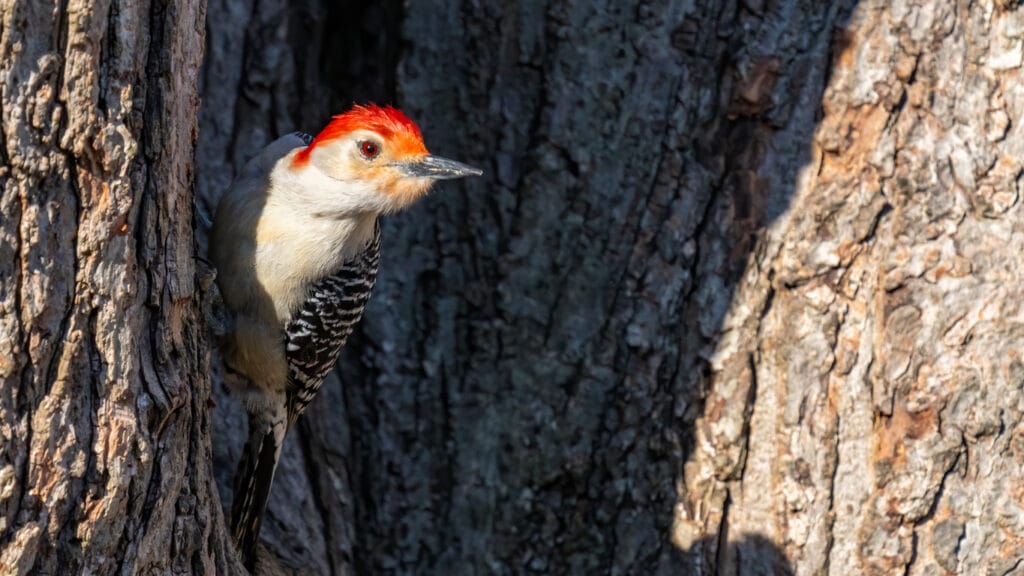
- Scientific name: Melanerpes carolinus
- Length: 9.1 to 10.6 inches
- Weight: 2.0 to 3.2 ounces
- Wingspan: 14.9 to 18.1 inches
- Average life span: 10 to 12 years
- Status: Least concern
If you’re out and about in Missouri, you’ll likely see a Red-bellied Woodpecker. The Red-bellied Woodpecker is one of the most common birds in Missouri, and you can find it all year round.
As you can guess by the name, this woodpecker has a red belly. However, it’s not the best way to identify these creatures. While you can see the patch of red feathers on the belly, it’s quite small. This makes it difficult for you to see it from a distance.
So, the best way to identify this bird is the red patch on its head. The Red-bellied Woodpecker has a bright red cap at the top of its head. It sits on top like a tiny red crown.
However, only the males of this species have the caps. This can make it challenging to tell females apart from other species.
Other than the red patches, the rest of this bird’s body is grayish-white. As for the wings, they have a black and white barred pattern.
8. Red-Headed Woodpecker

- Scientific name: Melanerpes erythrocephalus
- Length: 7.5 to 9.1 inches
- Weight: 2.0 to 3.4 ounces
- Wingspan: 14 to 17 inches
- Average life span: 9 to 12 years
- Status: Near threatened
The Red-headed Woodpecker is a Missouri native, and you can see it there all year round. However, you’re more likely to see one during the summer.
These birds are one of the easiest woodpeckers to spot. They have an incredibly distinctive red head. The red makes these birds stand out against trees and bushes.
You can also look out for their black and white wings. Unlike most other woodpeckers, the Red-headed Woodpecker has color-blocked wings. The top half of the wings is black, and the bottom is white. This creates a unique pattern in the air.
Still, finding a Red-headed Woodpecker doesn’t mean you can approach it. This woodpecker can be territorial. So, if you get too close, it could attack you.
Their beaks may look tiny, but they pack quite a punch. They can also peck you up to 20 times every second. For this reason, if you do see a Red-headed pecker, admire it from a distance.
9. Red-Cockaded Woodpecker
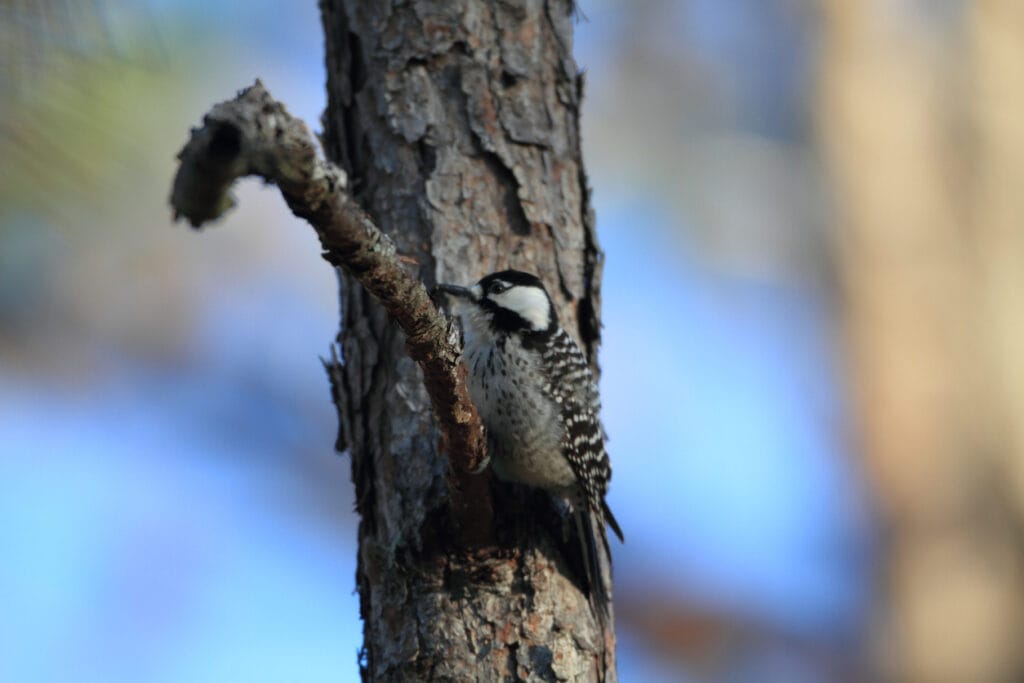
- Scientific name: Leuconotopicus borealis
- Length: 7.9 to 9.1 inches
- Weight: 1.5 to 1.8 ounces
- Wingspan: 12 to 15 inches
- Average life span: 10 to 12 years
- Status: Endangered
If you get incredibly lucky, you can spot a Red-cockaded Woodpecker in Missouri. A sighting of one of these woodpeckers is a rare occasion. After several fires, these birds are all but extinct in the area. However, some birds survived and still live there.
Still, their low numbers aren’t the only reason it’s hard to spot one of these peckers. The Red-cockaded Woodpecker can blend into its environment. Despite its name, this bird is mostly black and white.
It has barred wings and a black-and-white striped face. Only the males of this species have red feathers. Still, it’s a tiny patch on its cheek, so you’re not likely to see it from a distance.
Red-cockaded Woodpeckers like to stay together. They form flocks, or descents, and forage for food in packs.
This gives these birds a huge advantage for survival. They always forage together, and they help each other protect their young.
You can find them gathered around a large pine tree. Those trees house many insects and larvae, which are the woodpecker’s main food source. They also eat berries that grow around pine trees, like grapes and blueberries.
Author Note: Pine trees don’t only provide nourishment, but they also provide shelter. Most Red-cockaded Woodpeckers will burrow into the same tree they hunt around. It makes collecting food for chicks much easier.
However, this makes the Red-cockaded Woodpecker completely reliant on the pine tree. So, if anything were to happen to it, the bird would be vulnerable.
10. Ivory-Billed Woodpecker
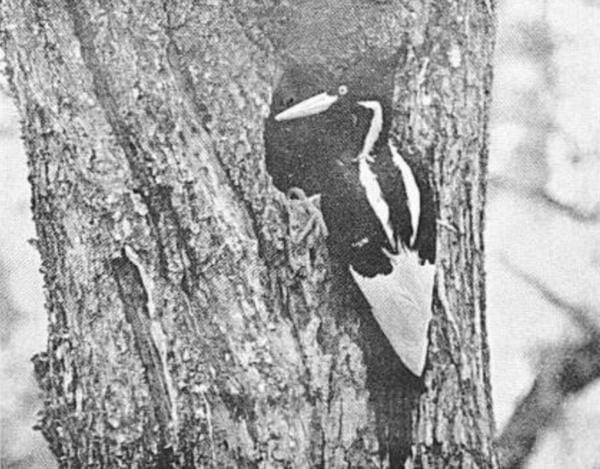
- Scientific name: Campephilus principalis
- Length: 18.9 to 20.9 inches
- Weight: 15.9 to 20.1 ounces
- Wingspan: 29 to 31.5 inches
- Average life span: 20 to 30 years
- Status: Declared extinct
One of the rare peckers you can find in Missouri is the Ivory-billed Woodpecker. These birds have the longest lifespan on our list. Still, because of habitat loss, most of them had to leave Missouri.
The Ivory-billed Woodpecker is also one of the largest species of woodpeckers. That means it needs much more space to fly around and hunt down its prey. This pecker likes to stalk its prey before it pounces.
Top Tip: These peckers have a distinctive appearance. Their body is solid black with two white stripes on either side. The only pop of color on this bird is a bright flash of red on the back of the head.
Ivory-billed Woodpeckers get their name from their bills. Their bills are ivory and incredibly strong.
The tip of their bills tapers into a flat shape. This allows the woodpeckers to cut into trees like a chisel. They also have barbed tongues, which help them grab onto prey.
Wrapping Up
Missouri is an amazing spot to go looking for woodpeckers. They have 10 different species of woodpeckers that you can keep an eye out for.
Each one of those species has its nesting and migrating habits. So, that means you should be able to find one any time of the year.
FAQ
To find out where recent sightings of woodpecker have been, try eBird. You can search for the latest sightings or particular species or what has been seen in a certain area.
There are several species that could fight for this title. At least 4 of the species listed above are very common across Missouri.
Begin with this locations:
Eagle Bluffs Conservation Area,
Mingo National Wildlife Refuge – Red-headed Woodpecker
August A. Busch Memorial Conservation Area/Weldon Spring CA, Roaring River State Park – Pileated Woodpecker




